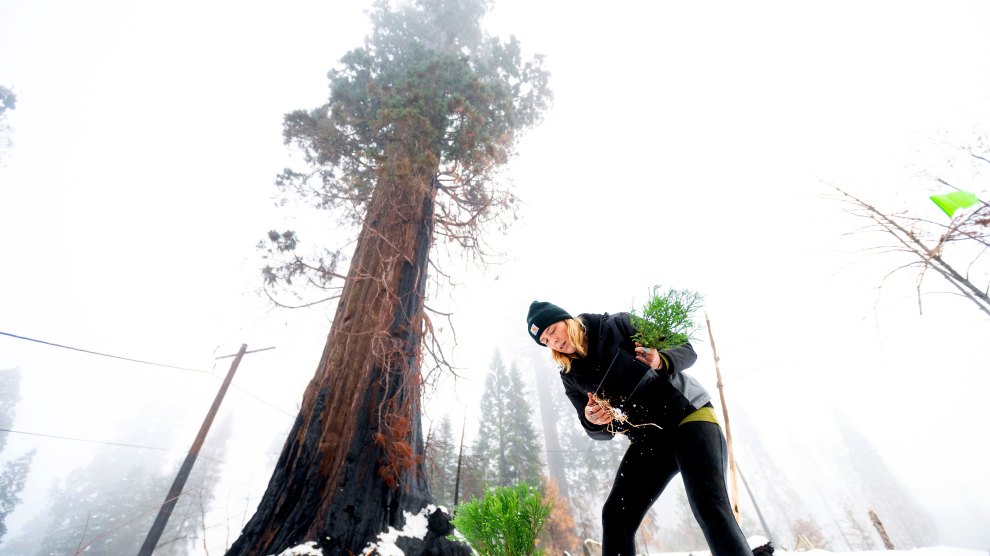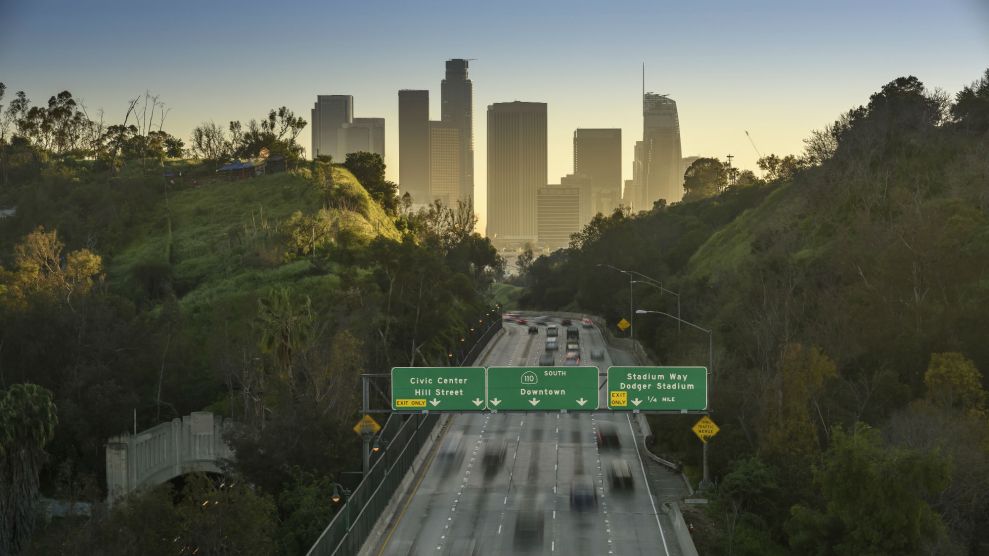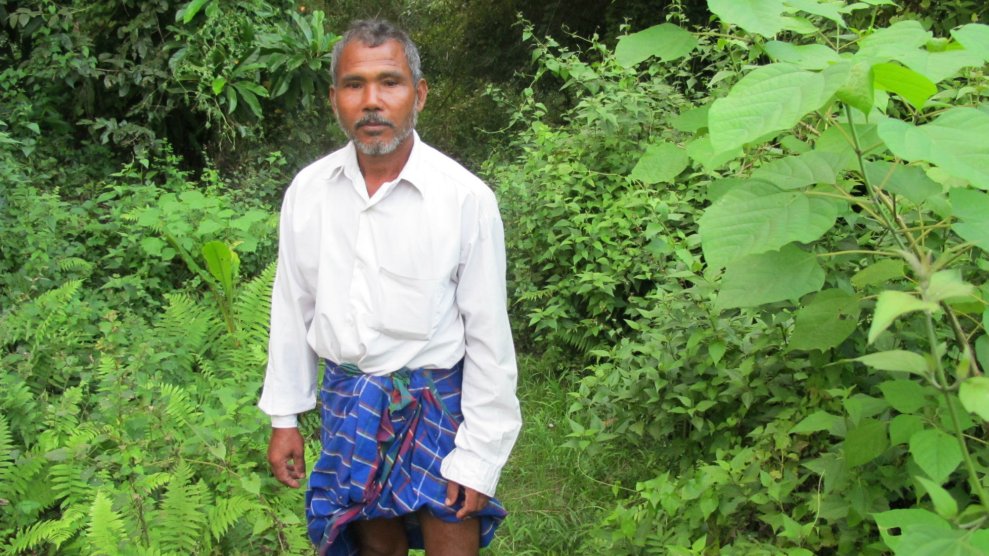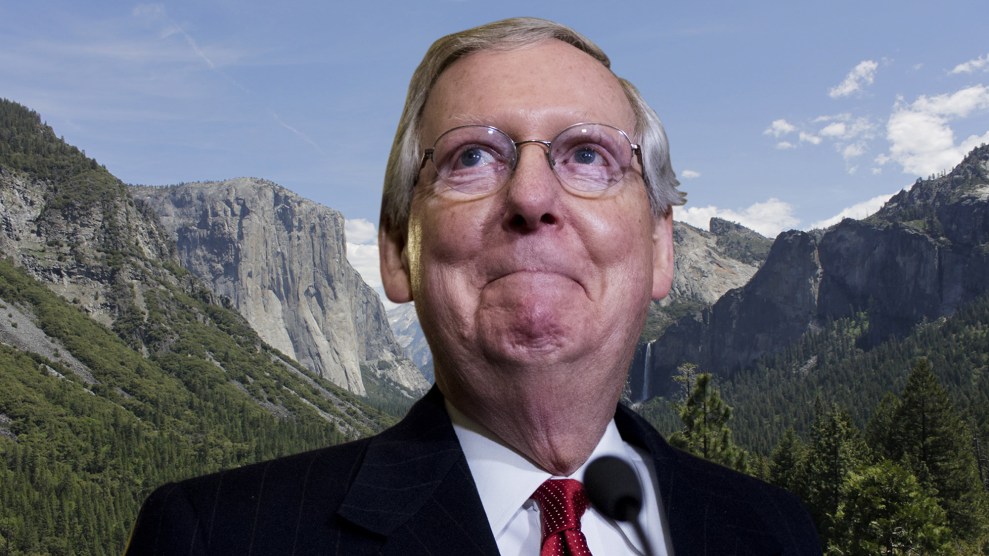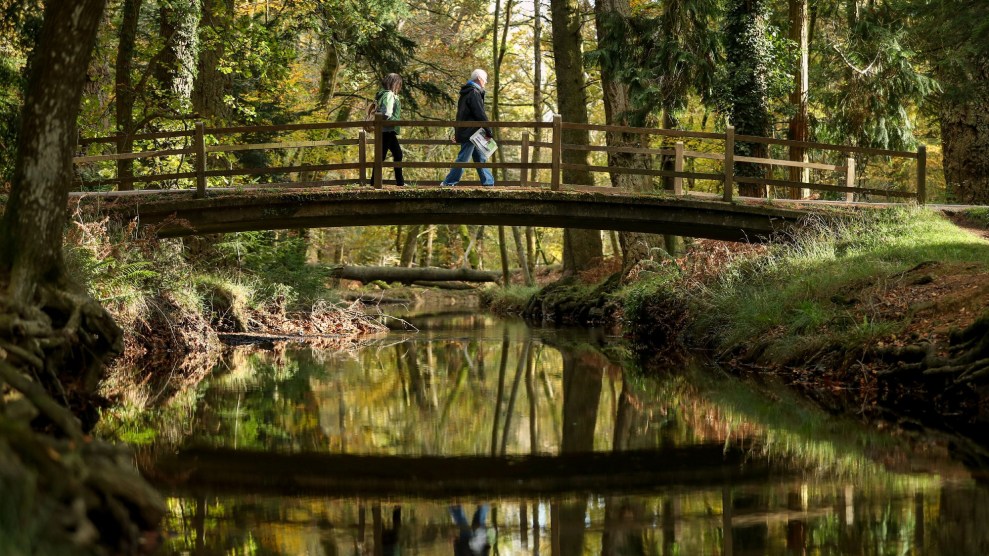
Andrew Matthews/ Press Association via AP Images
This story was originally published by the Guardian and is reproduced here as part of the Climate Desk collaboration.
How happy do you feel right now? The question is asked by an app on my phone, and I drag the slider to the space between “not much” and “somewhat.” I’m about to start a walk in the woods that is part of a nationwide research project to investigate how better to design the forests of the future.
Volunteers are being sought to record their feelings before and after eight walks via a free app, Go Jauntly, which could reveal what kind of treescapes most benefit our well-being and mental health. I’m feeling frazzled after a week of delayed trains that led me to drive three-and-a-half hours to the Staffordshire village of Barton-under-Needwood, where the walk begins. Surely my mood will be lifted by a leafy walk through the National Forest, a vast woodland emerging across the Midlands.
My guide is Miles Richardson, professor of nature connectedness at the University of Derby, who hopes the data he gathers from these Treefest walks will discover how the age, size, and shape of trees and woodlands benefit well-being. “With the government’s ambitious tree-planting targets, there’s going to be hundreds of new forests around the country,” said Richardson. “The whole project is about creating design tools so we can create the best treescape for 50 years’ time. Is the best way to do it with densely packed plantations of trees in regimented rows? Is that more beneficial to your wellbeing than a less linear approach? We don’t know.”
The Treefest research walks are part of a $16.7 million Future of the UK Treescapes program, an interdisciplinary quest involving multiple universities and investigating how to secure public benefits from forested landscapes.
We set off across green fields and are soon in a regimented plantation planted in the 1990s as part of the National Forest, 200 square miles of woodland stretching from Staffordshire to Leicestershire in areas historically scarred by coal mines.
Numerous scientific studies reveal the physiological and psychological benefits of time spent among trees, but there is not yet an understanding of how different kinds of treescape affect us. Research has shown that more biodiverse landscapes bring more mental and physical benefits to people and Richardson suspects that well-being will be enhanced more by wildlife-rich ancient woodlands than monocultural plantation forestry.
It is an instant relief to be away from traffic—the trees muffling all noise from the nearby A38—but the first lines of young ash trees dying from ash dieback disease don’t fill me with joy. Another snag is I have to keep checking the route on the Go Jauntly app. This has clear pictures alongside helpful directions, but I’m on the phone enough and don’t like using it when trying to wind down in nature.
Richardson, however, is keen to stress that tech is not a barrier to nature appreciation but can deepen it, or provide access for nature-averse communities. “We’re a technological ape and we’ve got to embrace it. It’s the way a tool is used that matters,” he said.
Where once I would have used a map, the app is guiding us, and Richardson believes that in the near future, “AI and digital assistance will do the legwork with connecting people with nature.” I’m imagining being guided through a wood by a virtual David Attenborough. “Perhaps Alexa will grow legs,” said Richardson. “You could have a digitally created face taking you out in the natural world, reassuring you and telling you where to go.”
The new plantation gives way to a patch of old oaks with an understory of hazel and holly, which is more chaotic and yet somehow more tranquil too. Then we’re out into a rolling landscape of pasture, grand parkland trees, with Dunstall village church on the horizon.
“We’re not in a woodland now but we are in a treescape,” said Richardson. “How close do trees have to be to start to matter to us? How dense do they have to be?” He hopes to gather enough data the walks to also examine how more biodiverse spaces might benefit well-being—through more birdsong, for instance. The lack of jarring noise on this walk is definitely helping me feel calmer and happier, and Richardson said he could record the noise on the eight research walks to examine this variable as well.
The program is also seeking to design climate-proof forests. “What trees can you plant when we have 40C summers with 20mm of rain each month? It’s also nice to think about planting woodlands that are designed so that there can be social prescribing or a counseling service within the trees,” said Richardson. “You can’t go for more than a five-minute walk in woodland here—you can’t go for a cool walk in a summer heatwave. In terms of future landscapes, a three-mile walk in a woodland close to where people live would seem to be pretty essential.”
Scores of peer-reviewed studies have identified the myriad benefits of wooded landscapes on everything from improved cardiovascular and immune system health to depression, which decreased with immersion in a forest alongside lower levels of anxiety, anger, confusion, and fatigue.
But it appears the type of forest may be important too: Intriguingly, several studies suggest that more biodiversity has a bigger boost on people’s mental health, while the recording of brain activity in response to forest density found a more relaxed state and reduced tension and fatigue in forests with a lower density of trees—from 30 percent to 50 percent—suggesting that densely packed conifer plantations aren’t so restorative.
My pleasure peaks when we enter a strip of deciduous woodland with a wide grassy ride that is brimming with life—dragonflies, meadow ants and speckled wood butterflies busy themselves as a green woodpecker cackles in the distance. I find it joyous witnessing an abundance of other animals living freely, and seeing other life up close puts my own worries into perspective—as does considering the long lifespan of these trees.
Of course, there is perpetual predation, disease, pain, and chronic anxiety in the nonhuman world too. And what about people who are fearful of forests or feel uncomfortable in the countryside? Richardson says if we ensure there is a wide variety of treescapes close to homes, people of all temperaments and backgrounds will be able discover the benefits of nature in their own way. “We’re a many and varied people and we just have to be sensitive to where people and communities are at and be sensitive to that in the design of the new treescapes,” he said.
At the walk’s end, I answer a series of questions about the trees and birds I encountered and how I feel. I’ve definitely reached the happier side of “somewhat” happy. But I notice the real benefits of our tree walk when I get home after another long drive: I’m glowing from the hours outside, relaxed, and energized.
Richardson added: “We need to find ways for everyone to have a closer relationship to nature because it’s good for well-being and it’s good for a sustainable future. That route is going to be different for different communities. The excitement is finding out what these solutions are and getting people involved in designing and developing and running them.”
